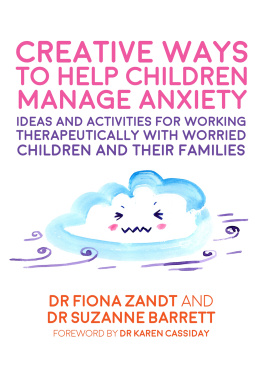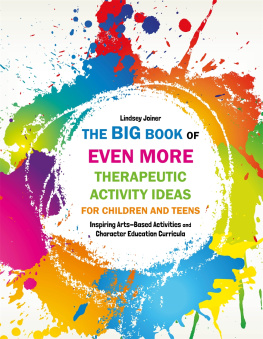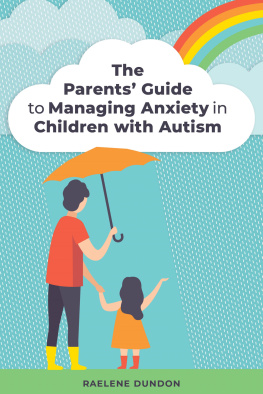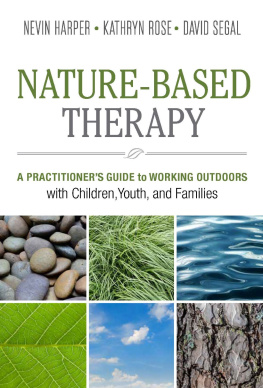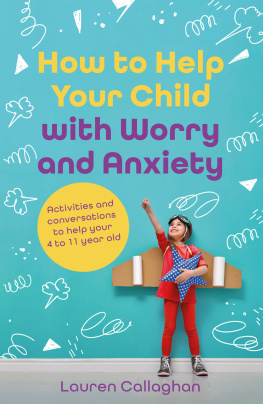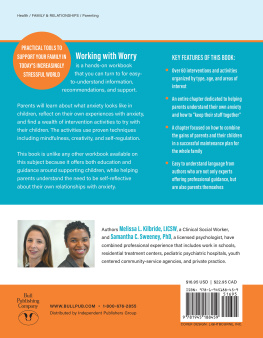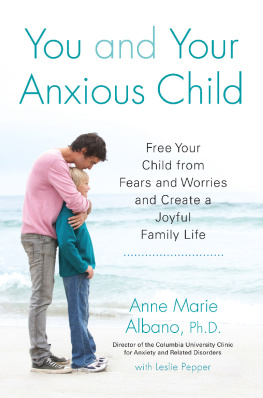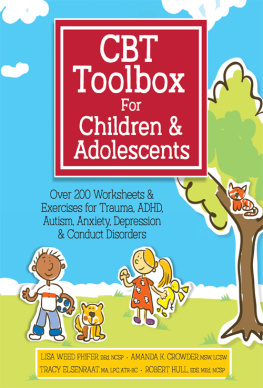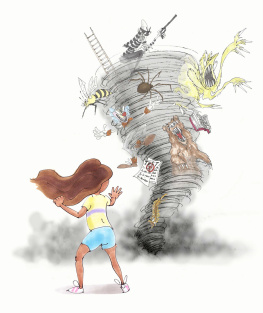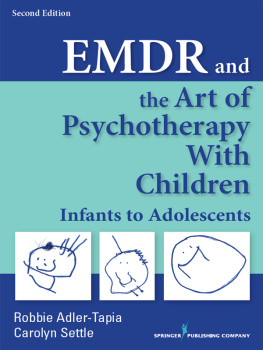Contents

CREATIVE WAYS
TO HELP CHILDREN
MANAGE ANXIETY
IDEAS AND ACTIVITIES FOR WORKING
THERAPEUTICALLY WITH WORRIED
CHILDREN AND THEIR FAMILIES
DR. FIONA ZANDT AND DR. SUZANNE BARRETT
FOREWORD BY DR. KAREN CASSIDAY
ILLUSTRATIONS BY RICHY K. CHANDLER

Contents
Therapeutic Activities
Foreword
One of the most difficult challenges for any child and adolescent therapist who works with anxious children is trying to make appealing a fundamentally unappealing task. The task of teaching children and their parents to face and manage their anxiety goes against the childs instinct to avoid and the parents desire to comfort. Evidence-based interventions for children necessitate therapeutic exposure to the very feelings and situations that the child, and even their parents, believes to be impossible. Having strategies that offer the possibilities for fun and that harness a childs imagination and spirit of learning through play have a great advantage over simply offering rewards for participation in treatment. Children, and quite frankly adults, all learn better by doing. Children also naturally use play to explore things that are challenging, difficult to understand and distressing. That means that any therapist who works with children is going to have to figure out how to incorporate play, good humor and imagination to help children acquire the skills to overcome anxiety successfully.
The other dilemma that many therapists face is that they have spent a lot of time in school, including graduate school. This means that they have likely had the fun beaten out of them and have spent many hours engaged in a type of learning that emphasizes listening to an expert pontificate, focussing upon gaining a new graduate level of vocabulary, known as professional jargon, and being very serious. Therapists have also probably spent very little time playing, watching kid-related media and doing the things that make it easy to be spontaneous, silly and, quite frankly, kid-attractive. It is also likely that their graduate training emphasized following a particular protocol that did not focus upon play but instead focussed upon treatment fidelity. They may have been told to offer candy or stickers at the end of every session, but this is often a poor motivation for a child who is freaking out with panic and can only imagine how to flee your office. Sadly, these are not the skills that make clinicians kid-friendly.
So, if you want to succeed with kids, then you are going to have to learn how to play, to dance, to sing, to be silly and to speak without using jargon. You are going to have to forget about giving brilliant explanations and remember that kids learn best when they discover what works, when they use their imagination and when they view therapy as an adventure. Play is what makes this possible.
I invite you to enjoy this wonderful book that Dr. Zandt and Dr. Barrett have created for all of us grownup therapists who need a kickstart for our imagination. Dr. Zandt and Dr. Barrett have taken the complicated ideas that explain how anxiety works in the body and mind and created fun, memorable ways to explain and experience what happens when a child gets anxious and what to do once anxiety occurs. I love being playful and using play with my young patients because it puts the emphasis on joyful exploration and learning and takes the childs attention away from waiting for the next painful moment. We can all improve our therapist play skills, because our status as grownups who must constantly learn at a graduate level compromises our ability to be playful. This book is one that I am sure you will enjoy as you implement its suggestions with your patients and both discover how joyful it is to overcome anxiety, kid-style!
Dr. Karen Cassiday
Preface
Worries and fears are a normal part of childhood. However, at times anxiety reaches a point where it becomes problematic for children. Anxiety disorders are the most common mental health conditions affecting children, are often chronic and are associated with mental health difficulties in adulthood (Farrell, Ollendick and Muris 2019).
Anxiety, in its many forms, is one of the most common reasons that children and families present for therapy. Untreated it can have a significant impact on many areas of a childs development and can result in marked stress and strain for families. As therapists we need to be able to work well with children with anxiety and their families. In this book we outline our playful, purposeful and practical ideas for working therapeutically with children with anxiety.
First, and perhaps most essentially, our approach with children is playful. Play is a childs natural form of communication. It provides them with many essential skills, including learning about relationships, developing self-regulation, learning to negotiate and repair, assessing risk, making sense of their world and practicing new behaviors or roles. Piaget (2000) contended that children learn best when they are actively involved, doing and exploring, and using play in therapy is a great way to help children learn about therapeutic concepts. In therapy we scaffold for the child, supporting their learning and allowing them to engage more with therapeutic concepts than they are able to do independently. We create what Vygotsky (1986) referred to as the zone of proximal development, in which a child can learn through interacting with someone who is more experienced. Play also provides opportunities for practice and repetition, while encouraging flexibility. For example, a child who is engaged in a role play can try out different ways of responding to worries.
Perhaps most importantly, play is engaging, calming and fun for children. This aspect of play should not be underestimated. Having fun in therapy ensures that children feel helpful about coming and makes it more likely that they will want to come again. For some children the opportunity to share enjoyable time with a supportive and caring adult will be a rare experience, and in some instances this may be the most valuable contribution of our therapy time with the child.
Being playful requires us to be open and flexible, to not be focussed on competence, and instead be immersed in the process. One aspect of being playful is that we share a little of ourselves in the play. For example, when talking about the childs feelings, we would share a little about our own feelings, taking care to share only what is appropriate and supports the childs therapy. Some therapists are naturally more playful than others and sometimes this is understandable in the context of our own play history. The same will also be true for the parents we work with. Noticing your own tendencies and finding ways to work that suit your style and setting is important.
We use play in a directed way to help children understand and explore therapeutic concepts. We use a cognitive behavioral therapy (CBT) approach (including acceptance and commitment therapy) with systemic family therapy and narrative therapy influences. Our approach is therefore purposeful. We remain goal-focussed, being clear about the therapeutic concepts we want to work on with children. The goals are derived from our understanding of the child and their difficulties with anxiety in the context of their family and broader systems. As therapists we often think of this as our formulation; and regardless of the model we are trained in, this emphasizes the importance of assessment. Completing a comprehensive assessment and sharing our understanding with the family provides a space in which we can develop goals and keep our therapy focussed and purposeful.

